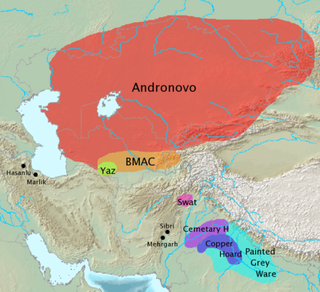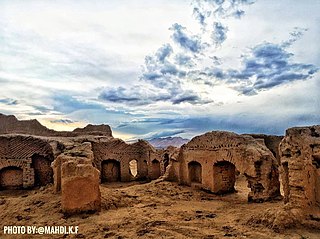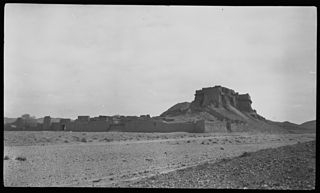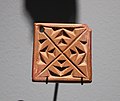The Iron Age is the final epoch of the three historical Metal Ages, after the Chalcolithic and Bronze Age. It has also been considered as the final age of the three-age division starting with prehistory and progressing to protohistory. In this usage, it is preceded by the Stone Age and Bronze Age. These concepts originated for describing Iron Age Europe and the Ancient Near East. The indigenous cultures of the New World did not develop an iron economy before 1500.

Tajikistan, officially the Republic of Tajikistan, is a landlocked country in Central Asia. Dushanbe is the capital and most populous city. Tajikistan is bordered by Afghanistan to the south, Uzbekistan to the west, Kyrgyzstan to the north, and China to the east. It is separated from Pakistan by Afghanistan's Wakhan Corridor. It has a population of approximately 10.6 million people.

The 5th millennium BC spanned the years, that is, inclusive of 5000 BC but exclusive of 4000 BC. It is impossible to precisely date events that happened around the time of this millennium and all dates mentioned here are estimates mostly based on geological and anthropological analysis.

The Bactria–Margiana Archaeological Complex (BMAC) is the modern archaeological designation for a particular Middle Bronze Age civilisation of southern Central Asia, also known as the Oxus Civilization. The civilisation's urban phase or Integration Era, was dated in 2010 by Sandro Salvatori to c. 2400–1950 BC, but a different view is held by Nadezhda A. Dubova and Bertille Lyonnet, c. 2250–1700 BC.

Panjakent or Penjikent is a city in the Sughd province of Tajikistan on the river Zeravshan, with a population of 52,500. It was once an ancient town in Sogdiana. The ruins of the old town are on the outskirts of the modern city. The Sarazm Important Bird Area lies downstream of the city on the tugay-vegetated floodplain of the river.

The Andronovo culture is a collection of similar local Late Bronze Age cultures that flourished c. 2000–1150 BC, spanning from the southern Urals to the upper Yenisei River in central Siberia and western Xinjiang in the east. In the south, the Andronovo sites reached Tajikistan and Uzbekistan. It is almost universally agreed among scholars that the Andronovo culture was Indo-Iranian. Some researchers have preferred to term it an archaeological complex or archaeological horizon.

Shahr-e Sukhteh, c. 3550–2300 BC, also spelled as Shahr-e Sūkhté and Shahr-i Sōkhta, is an archaeological site of a sizable Bronze Age urban settlement, associated with the Helmand culture. It is located in Sistan and Baluchistan Province, the southeastern part of Iran, on the bank of the Helmand River, near the Zahedan-Zabol road. It was placed on the UNESCO World Heritage List in June 2014.

Central Asian cuisine has been influenced by Persian, Indian, Arab, Turkish, Chinese, Mongol, African and Russian cultures, as well as the culinary traditions of other varied nomadic and sedentary civilizations. Contributing to the culinary diversity were the migrations of Uyghur, Slav, Korean, Tatar, Dungan and German people to the region.

The Yaz culture was an early Iron Age culture of Margiana, Bactria and Sogdia. It emerges at the top of late Bronze Age sites (BMAC), sometimes as mud-brick platforms and sizeable houses associated with irrigation systems. Ceramics were mostly hand-made, but there was increasing use of wheel-thrown ware. Bronze and iron arrowheads, also iron sickles and carpet knives among other artifacts have been found.
The Yaghnobi Tajiks, commonly referred to as Yaghnobis, are an Eastern Iranian ethnic group residing in Tajikistan's Sughd province, specifically in the valleys of the Yaghnob, Qul, and Varzob rivers. Although they are considered part of the broader Tajik ethnicity, they are distinguished from other Tajiks by their use of the Yaghnobi language, an eastern Iranian language.
Tapeh Yahya is an archaeological site in Kermān Province, Iran, some 220 kilometres (140 mi) south of Kerman city, 90 kilometres (56 mi) south of Baft city and 90 km south-west of Jiroft. The easternmost occupation of the Proto-Elamite culture was found there.
Konar Sandal is a Bronze Age archaeological site, situated in the valley of the Halil River just south of Jiroft, Kermān Province, Iran.

Takht-i Sangin is an archaeological site located near the confluence of the Vakhsh and Panj rivers, the source of the Amu Darya, in southern Tajikistan. During the Hellenistic period it was a city in the Greco-Bactrian kingdom with a large temple dedicated to the Oxus, which remained in use in the following Kushan period, until the third century AD. The site may have been the source of the Oxus Treasure.

Gonur Depe is an archaeological site, dated from 2400 to 1600 BCE, and located about 60 km north of Mary, Turkmenistan consisting of a large early Bronze Age settlement. It is the "capital" or major settlement of the Bactria–Margiana Archaeological Complex (BMAC).

Mundigak is an archaeological site in Kandahar province in Afghanistan. During the Bronze Age, it was a center of the Helmand culture. It is situated approximately 55 km (34 mi) northwest of Kandahar near Shāh Maqsūd, on the upper drainage of the Kushk-i Nakhud River.

The prehistory of the Iranian plateau, and the wider region now known as Greater Iran, as part of the prehistory of the Near East is conventionally divided into the Paleolithic, Epipaleolithic, Neolithic, Chalcolithic, Bronze Age and Iron Age periods, spanning the time from the first settlement by archaic humans about a million years ago until the beginning of the historical record during the Neo-Assyrian Empire, in the 8th century BC.

Tepe Hissar is a prehistoric site located in the village Heydarabad just south of Damghan in Semnan Province in northeastern Iran.

The Vakhsh culture is a Bronze Age culture which took place around 2500-1650 BC, as shown by radiocarbon dates, and flourished along the lower Vakhsh River in southern Tajikistan, earlier thought to be from ca. 1700 BC to 1500 BC.

Sassui Punnhu Fort, , also known as Miri Kalat, is a historical site and tourist spot near Turbat City in Turbat Tehsil, Kech District, Balochistan, Pakistan. The ancient archaeological site is located near the fort in which ancient graves are sited. In the graves, the skeletons of humans are openly laid into graves. The fort is now on the verge of disappearance.
Said Qala Tepe is an archaeological site near Kandahar in Afghanistan. The tell is about 8 meters high and 200 × 200 meters in area. It has produced particularly strong evidence for the prehistoric period, showing an intensive settlement of the site in the fourth and third millennium BC, attributed to the Helmand culture.
































